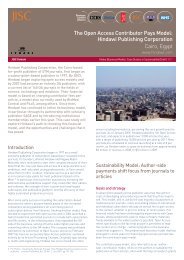A Concise Guide to Researching Audiences - Strategic Content ...
A Concise Guide to Researching Audiences - Strategic Content ...
A Concise Guide to Researching Audiences - Strategic Content ...
Create successful ePaper yourself
Turn your PDF publications into a flip-book with our unique Google optimized e-Paper software.
The <strong>Guide</strong> <strong>to</strong> <strong>Researching</strong> <strong>Audiences</strong><strong>Concise</strong> editionMethodQuantitativesurveys‘Traditional’webstatistics 11Web analyticsUserobservationtechniques(ethnography)InformationDescription: Quantitative surveys involve using a sample of an audience/population as the basis forproducing a statistically reliable picture of the whole. Includes postal, email, telephone, and internetsurveys.Uses: For providing quantifiable information about an audience. For example, its profile and its patternsof usage and behaviour.Pros: Vary depending on method. In general: cost-effective, offer a large proportion of relevant audiencea chance <strong>to</strong> respond, low level of commitment from respondents, internet and email surveys can providevery immediate feedback.Cons: Vary depending on method. In general: sample is often self-selecting, no guarantees of responserates, method should be chosen carefully (ie not all potential respondents will have internet access or willbe comfortable using it), interpretation of questions can be subjective.Description: Web servers generate log files when they serve a request, which is typically directly from a‘user agent’ – usually a browser such as Internet Explorer or Firefox. These log files record the requestwhich was made, the status of the response (success, failure etc) and some basic information about theuser agent. This method considers relatively simple ways in which these log files can be processed <strong>to</strong>generate quantitative information (web statistics) regarding the use of the service.Uses: For understanding, on aggregate, the ways in which an online resource (or collection of resources)is used, for example the relative usage of different parts of a site, and how the usage varies over time.Pros: Low cost in time and effort, information can be available immediately, provides an ‘at-a-glance’view of how busy a site is, and which sections of the site are most used.Cons: Limited insight in<strong>to</strong> user behaviour, very crude measures of demographic of audience, tempting <strong>to</strong>infer <strong>to</strong>o much from the information which is available.Description: Web analytics is a more advanced method for investigating the actions of users. Webanalytics will include the information available from traditional web statistics, but whereas web statisticsis focused on the resource, web analytics is focused on individual users. The actions of these users canbe combined <strong>to</strong> provide bulk information on a service, but at a far higher level of detail than that availablefrom traditional web statistics.Uses: Web analytics can be particularly helpful <strong>to</strong> support site design decisions, by understanding thedecisions that users take when using a resource.Pros: Information can be available immediately, provides extensive information on user behaviour, can beused <strong>to</strong> segment users based on a range of behaviours and possibly on demographics.Cons: Commercial web analytics packages are expensive, setting up reporting is time-consuming anddemands good business and technical knowledge, insight in<strong>to</strong> user behaviour from web statistics must bevalidated.Description: Ethnography is a term used <strong>to</strong> encompass a wide range of techniques and approaches.At its core is a desire <strong>to</strong> understand human culture by observing behaviour, but this broad principle isincreasingly used in commercial, public and social research contexts. It includes user tracking studies(eg shadowing, diary studies) and use testing (eg task-focused activity sessions).Uses: Ethnography and observational techniques can offer an insight in<strong>to</strong> how audiences use and interactwith services and resources. For digital services very detailed data about usage can often be capturedunobtrusively by computer logging techniques.Pros: Vary depending on method. Example – use testing is an excellent way of identifying problems withusability.Cons: Vary depending on method. Generally time-consuming and resource intensive.1111 In this document, we have divided the measurement of online resources in<strong>to</strong> ‘traditional’ web statistics and web analytics. This is a somewhatartificial boundary, but one that is necessary <strong>to</strong> consider the full range of opportunities. Traditional web statistics consider bulk information ona resource (ie looks at usage from the service’s perspective), whereas web analytics considers the actions and pathways chosen by individualusers (so looks at usage from a user’s perspective).4. Collecting audience data PAGE 21



